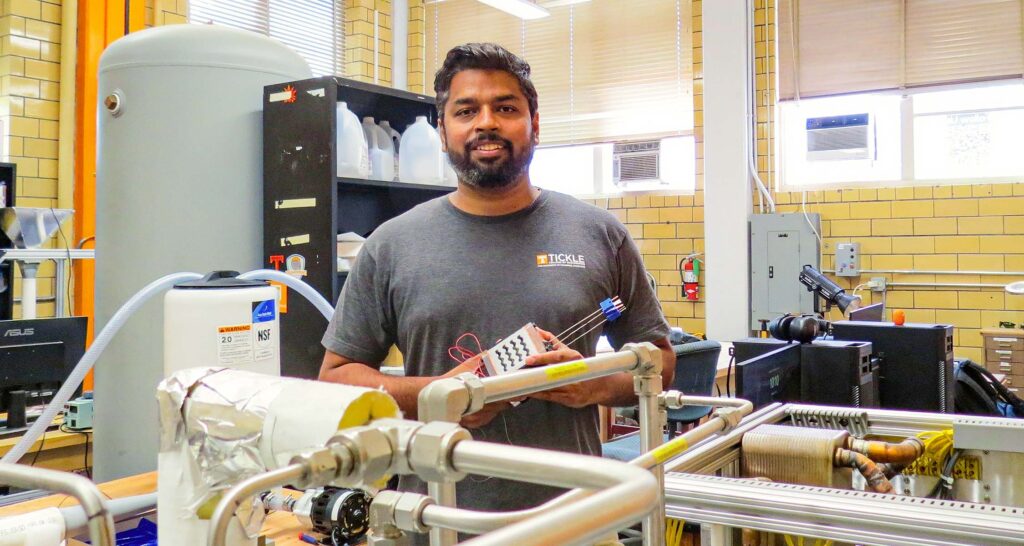In response to the growing need for energy-efficient technologies, Prashant Singh and his team at the Heat Transfer Laboratory (HTL) are pushing the boundaries of thermal engineering. Their mission is to design compact, high heat duty heat exchangers capable of meeting the rigorous demands of modern applications—from power electronics and heat pumps to concentrating solar thermal power (CSP) systems.
Singh, an assistant professor in the Department of Mechanical and Aerospace Engineering, is pioneering the development of highly power-dense heat exchangers that not only meet extreme thermal requirements within limited space but also reduce manufacturing and operational costs.
“This is a multidisciplinary challenge at the intersection of thermal science, materials engineering, advanced manufacturing, and technoeconomics,” Singh said. “We are excited to be developing technologies that are both scalable and near-market-ready.”
Singh’s group is working alongside collaborators from national laboratories, academia, and industry to design custom-engineered lattice structures that can be additively manufactured in a variety of metals. These highly porous, lightweight, tunable unit cell topologies are optimized for enhanced heat transfer across a wide temperature range, making them ideal for diverse applications.
“We’ve focused heavily on high-heat flux dissipation,” Singh said. “Our multifunctional, porous-media-based designs have shown exceptional promise in systems such as particle-to-supercritical carbon dioxide heat exchangers for CSP plants, avionics cooling, power electronics, industrial drying, and high-efficiency heat pumps.”
The group’s work has attracted funding from major agencies, including the U.S. Department of Energy (DOE), National Science Foundation (NSF), and National Aeronautics and Space Administration (NASA).
“We’ve built robust experimental capabilities in our lab that support both early-stage concept development and high technology readiness level (TRL) demonstrations,” Singh said. “Our goal is to translate these innovations into real-world solutions that accelerate the transition to a more energy-efficient future.”
From Lab to Market
The HTL conducts cutting-edge research in enhanced heat transfer technologies for a broad spectrum of energy-related applications.
The lab is distinguished by its expertise in advanced non-intrusive thermal diagnostics, such as liquid crystal and infrared thermography, enabling precise characterization of enhanced heat transfer concepts. HTL leverages state-of-the-art manufacturing techniques, including additive manufacturing, subtractive methods, and casting, to fabricate custom heat-exchanger modules.
Youssef Aider, a PhD student on Singh’s team, has been working in the lab for the last five years. One of his main projects concerned renewable energy, particularly concentrating on solar power plants.
“It’s been a great experience for me,” Aider said. “We work on state-of-the-art research on thermal energy storage, which is really important in the future. I’ve gained a lot of experience from that, and from electronic cooling. We have worked on a lot of state-of-the art ways of improving the heat transfer coefficient that is very useful for electronic cooling.”
The lab is equipped with experimental facilities that can test a variety of working fluids, addressing thermal challenges in wide range of applications. Thermal transport characterization is carried out by utilizing experiments, math, and computer models along with inverse-heat-transfer to obtain detailed measurements of how heat is exchanged over time and space at the surfaces where materials touch.
“With the use of additive manufacturing and conventional manufacturing, you can have a very compact heat exchanger, which doesn’t need to be that big to achieve the same task,” Singh said. “So, it can be really compact, less costly—and not just one-time upfront cost, but also the operational cost will go down if the heat exchangers become this high performing.”
Contact
Rhiannon Potkey (rpotkey@utk.edu)
